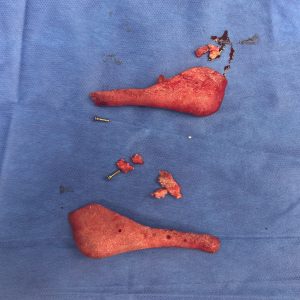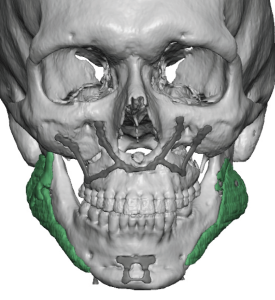Case Study: Jaw osteotomies are commonly performed with high degrees of success and few significant complications. They are very effective at improving lower face proportions and projection as well as occlusal interdigitation. But like all operations it is not perfect and does have some aesthetic tradeoffs. These aesthetic liabilities include bony irregularities and some dimensional limitations.
While the sagittal split osteotomy does lengthen the lower jaw (when advancements are performed) it does so by keeping the same amount of bone. While most of the residual bone defects created are partially hidden by the reapproximation of the proximal and distal bone segments some of them occur along the inferior border.This causes a disruption of a pre-existing smooth inferior border bone contour. The inferior border bone disruption creating by the anterior chin osteotomy is more recognized with the well known notch deformity at the back end of the osteotomy cut. But when the sagittal split and chin osteotomies are done together there is the high likelihood that the patient will experience some of these inferior border shape disruptions.
When trying to correct lower jaw inferior border irregularities after sagittal split and chin osteotomies the most effective method is going to be a custom jawline implant design. But such a custom jawline implant design is unique because some of the dimensional needs are located on the inferior border requiring some vertical augmentation along with whatever additional width dimensions are needed. The unique shape of the inferior border almost always requires a custom implant design to satisfactorily make it smoother. In that regard this is also where the implant material can have an impact on solving these dimensional needs. In some cases the implant material can be an important decision if smoothing out the inferior border irregularities is the primary objective.

Custom silicone jawline implants were designed make them slimmer with minimal width of 3 mm. You can’t have zero width as you need a flange for them to engage with the side of the jaw


There are numerous types of materials that can be used for custom facial implant designs. But they are not all created equal. Each material type has their advantages and disadvantages. There is no yet perfect facial implant material that is best for every single application or use. When trying to design a very thin implant for discreet bone defects it is more difficult to do so with a polyethylene material than that of a solid silicone due to how they are manufactured. Medpor implants tend to be thicker with less feathered edging because of their fabrication process. Their stiffness lends them to less risk of implant malposition albeit requiring bigger or longer incisions to place them. Conversely solid silicon can’t be manufactured down to the 1.5 mm level with very feathered edges. However it will have increased flexibility and placement therefore becomes more challenging and requires additional points of screw fixation. In this case the very discreet nature of the implant design lent itself better to a silicone material as it is hard to add vertical dimension to the inferior border without having some width addition as well.
Key Points:
1) Jaw and chin osteotomies can leave the inferior border of the jawline with irregularities and asymmetries.
2) A custom jawline is the only method of restoring the shape of the irregular jawline which often requires various amounts of vertical bony lengthening.
3) The choice of implant material can influence how small/thin a custom jawline implant can be.
Dr. Barry Eppley
World-Renowned Plastic Surgeon



